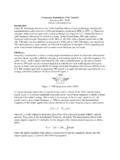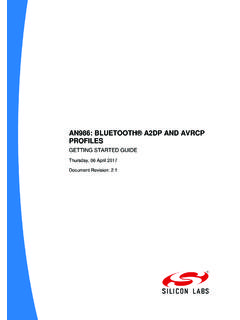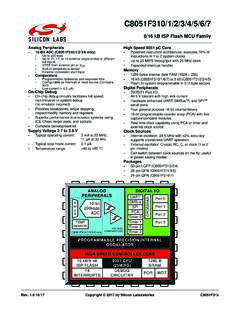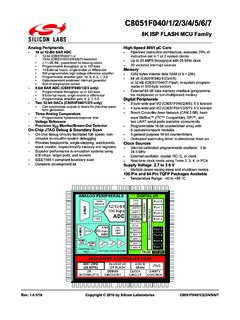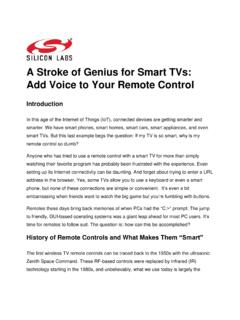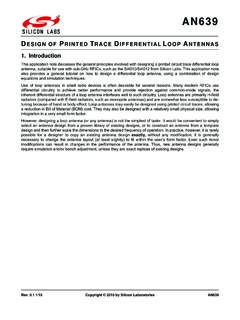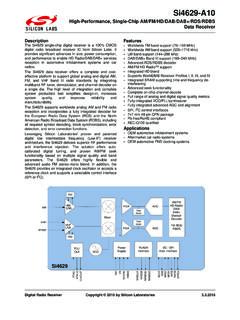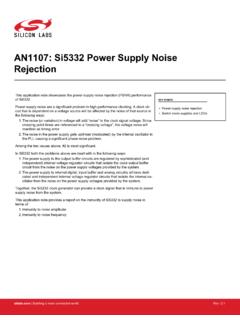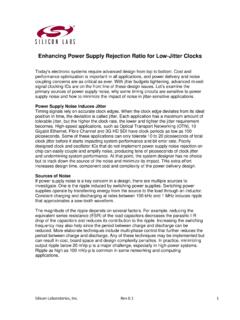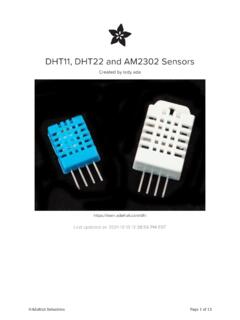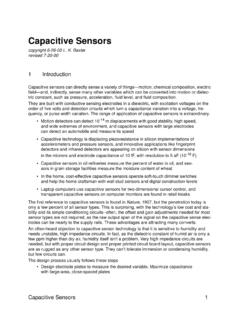Transcription of Hardware Design for Capacitive Touch
1 The world's most energy friendly microcontrollers2013-09-16 - Design for CapacitiveTouchAN0040 - Application NoteIntroductionThis application note covers the basics of Hardware Design for Capacitive touchsensing with the EFM32 microcontrollers. Both simple Touch buttons and moreadvanced sliders and Touch matrices are described, along with key pointers of howto achieve the best possible Capacitive Touch performance with the EFM32. Forthe lowest energy consumption and "wake on Touch " functionality, an EFM32 withLESENSE should be application note focuses on how to Design Hardware for Capacitive Touch withthe EFM32 microcontroller. For code examples, please refer to the Capacitive touchsoftware application note (AN0028).This application note includes: This PDF document Zip-file with schematic and gerber files for a Capacitive Touch example world's most energy friendly microcontrollers2013-09-16 - IntroductionCapacitive sensing is a technology now widespread across different industries.
2 High performancecapacitive sensors are capable of high resolution measurements of proximity, position, humidity, fluidlevels or acceleration of a conductive target. Lower cost Capacitive Touch sensors are less advanced areand mostly used for human-device interfaces by measuring the capacitance change when a user's fingeris nearby. These kind of sensors are increasingly common in devices with a human interface of all application note will focus on sensors used to interface with human users in applications focused onvery low power. Low power Capacitive Touch with the EFM32 can be implemented at low cost and bringmany advantages over mechanical switches. They have no moving parts which gives less degradationover time, with usage and with environmental changes. The EFM32 Capacitive Touch feature is primarilymade for implementing Capacitive Touch buttons and sliders with very low energy consumption, but itcan also be adapted to other Capacitive sensing EFM32's with analog comparator(s) are capable of Capacitive Touch .
3 For the absolute lowest energyconsumption, EFM32's with LESENSE (Low Energy sensor Interface) can use this peripheral to scanseveral Touch pads continuously and only wake the CPU when a Touch is of which EFM32 is used for Capacitive Touch sensing, the Design of printed circuit boards orsimilar Hardware for Capacitive Touch sensing follows the same guidelines which are explained furtherin this world's most energy friendly microcontrollers2013-09-16 - Capacitive Sensing BasicsFigure Capacitive Sense OverviewGroundVirt ual groundC baseC t ouchOverlayLam inat e (FR4) Working PrincipleThe working principle of a Capacitive Touch (or proximity) sensor is to measure the change in capacitanceof a given, and otherwise constant, capacitance when approached or touched by a larger body suchas a human finger or hand. The Capacitive Touch pad can be implemented with different technologies,ranging from a trace on a printed circuit board to various conductive coated surfaces like glass or PCB approach is often combined with an overlay or cover panel, typically made of some kind ofplastic or implementing a Capacitive Touch sensor there are a few possible configurations which can becategorized in two different types; self- and mutual-capacitance.
4 The difference is between which twonodes the capacitance is measured. It can either be between the Touch pad and another electrode withdifferent potential than ground, which is the mutual-capacitance type of setup. Or it can be between thetouch pad and ground, which is the self-capacitance type of setup. The EFM32 is designed for self-capacitance measurements where the change in capacitance between a Touch -pad and ground is themeasured EFM32s way of measuring changes in capacitance is by using the analog comparator to set upan RC relaxation oscillator. The oscillating circuit includes the capacitance between the Touch -pad andground as the Capacitive element. The implementation can be seen in Figure (p. 4) . By countingthe number of oscillations during a fixed time interval, an indication of the capacitance in the RC circuitis acquired. This count value can be compared against a threshold value to determine if a sensor istouched or not because a change in count value indicates a change in world's most energy friendly microcontrollers2013-09-16 - Analog comparator RC relaxation oscillatorVDD/4 VDD_SCALEDBut t onsPOSSELThe quality of a Touch measurement is correlated with how much the capacitance between the pad andground changes upon human Touch .
5 This can be directly translated to how large the observed changein count value is when a human finger touches the pad compared to the non-touched count value. Thegoal of Hardware Design for Capacitive Touch is to maximize this change when a human finger touchesa pad as well as minimize sources of (p. 3) illustrates a typical Capacitive Touch button with a finger approaching. The term"virtual ground" refers to the fact that a finger placed close to the Capacitive Touch pad acts as an electricalbody which has a finite impedance to the Capacitive Touch circuit's own typical parameters of the RC oscillator and the capacitance of a pad is listed below. Frequency: 100 kHz - MHz Capacitance of pad: 5 pF - 15 pF Change in capacitance upon Touch : - 50% Typical measurement window: - Signal-to-Noise RatioThe change in capacitance when a finger is placed near the sensor element is generally very small.
6 Thismeans that noise in the measurements needs to be kept even smaller to be able to reliably differentiatebetween actual touches and noise. The signal-to-noise ratio (abbreviated SNR) is a way to quantitativelycompare the performance of different solutions, both Hardware - and SNR definition used in this application note is the same as for the Capacitive Touch softwareapplication note (AN0028). Any definition of SNR could in principle be used to compare differenthardware designs. The one chosen here is based on the measurement principle that is used by given capacitance between the pad and ground is represented by a count value as described inSection (p. 3) . The "signal" refers to the difference between the average count for Touch andno Touch . The ratio between this difference and the noise for an untouched button is the SNR.
7 SeeFigure (p. 5) for an example of SNR. As illustrated the target is to keep the SNR higher than term "noise" as used in this document refers to the absolute peak to peak difference observed inthe count values for otherwise static conditions. This is a useful definition since the statistical distributionis unknown and less frequently occurring peak values should be taken into account because they canlook like false world's most energy friendly microcontrollers2013-09-16 - a rule of thumb, the SNR should be above developing a Capacitive Touch application one should check that the SNR criterion is fulfilled forthe actual PCB with the final overlay (same material and thickness that will be used). For evaluation ofthe SNR the reader is referred to the Capacitive Touch software application note (AN0028).Figure Signal to noise ratioCount ValueSam ple # N3 Noise [e]Signal = 5* eNo Touch ValuesTouch External DisturbancesExternal disturbances and environmental changes that can affect either the actual capacitance of asensor or a change in the measured capacitance are listed below.
8 Some of these can be dealt with byimproving the Hardware Design (marked " Hardware "). Some are inherent with the working principle ofthe capacitance measurement and should be handled by software (marked "software"). Radiated and conducted noise from other components, traces and power supply. ( Hardware ) Changes or noise in supply voltage. (Software/ Hardware ) Changes in temperature. (Software) Changes in humidity. (Software) Jitter in the low frequency (LF) oscillator frequency. ( Hardware )This document focuses on minimizing the Hardware related disturbances. The ones marked software isdiscussed in the Capacitive Touch software application note (AN0028)..the world's most energy friendly microcontrollers2013-09-16 - sensor DesignHow the actual Touch pads and printed circuit board are designed has a significant impact on theperformance of the Capacitive Touch solution.
9 Parameters such as size and shape of the pads andhow the signals are routed affects the signal integrity. The following section discusses what affectsperformance and best Design Touch ButtonsFor simple Touch buttons there is mainly one parameter of the pad itself that matters the most; size. Theshape and how far apart the pads are placed should also be considered to minimize false detection onneighboring Button ShapeA round button is best, but other shapes works as well. The corners should be rounded as much aspossible, this will minimize stray field lines and focus the strongest field right above the button itself. SeeFigure (p. 6) for an illustration of the Touch button parameters; D - Diameter/Size, S - Spacingand ground clearance. The partly covering hatched ground and ground clearance are explained furtherin Section (p.)
10 10) .Figure Simple Button DesignSDPrim ary LayerSecondary LayerGNDT ouch Pad SignalsHat ched GroundTouch PadGND Button SizeThe size of the buttons should be similar to the footprint of a touching finger. For circular pads thisequates to a diameter of approximately 15 mm. Any diameter between 10 mm and 20 mm is fine. Theexception to this would be proximity sensing and sensing through thick overlays. To increase the strengthof the field further away from the surface of the overlay, the pad can be made larger. For an illustrationof how the pad size affects SNR through different overlay thicknesses, see Figure (p. 11) . SpacingIt is important that the Touch pads are spaced far enough apart so that a Touch does not also triggerneighboring pads. This can be handled by software as well, because almost always, one of the padswill have the strongest spacing is also dependent on the thickness of the overlay.
